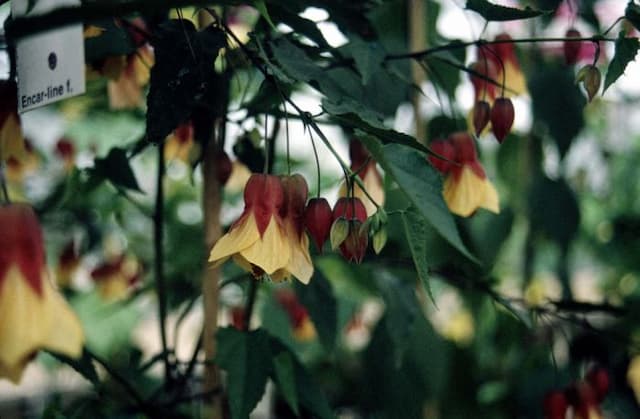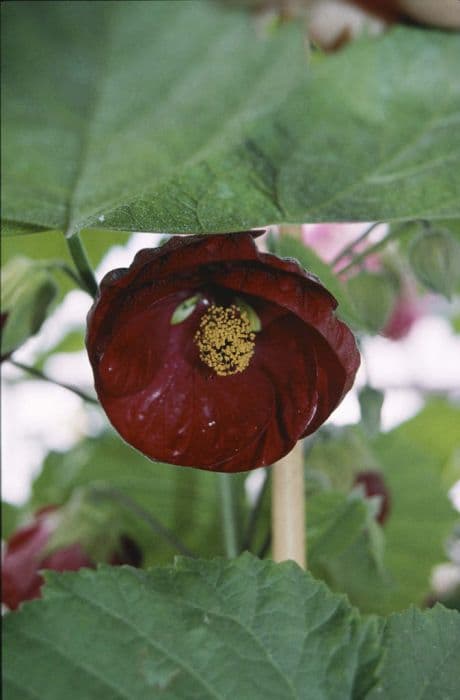Rose of Sharon Hibiscus syriacus 'Admiral Dewey' (d)

ABOUT
The Hibiscus syriacus 'Admiral Dewey', commonly known as Rose of Sharon, is an ornamental shrub notable for its lush, showy flowers and appealing foliage. It displays a profusion of large, double blooms characterized by their delicate, pale pink petals that can create a romantic and soft visual impact in any garden setting. The blooms often feature a deeper pink or red center that adds depth and contrast to the flower, enhancing its overall beauty. The flowers blossom in the warmer months, providing a long-lasting display that can attract pollinators such as bees and butterflies. In addition to its striking flowers, the Rose of Sharon has a lush, green foliage. The leaves are typically heart-shaped or three-lobed with a slightly toothed edge, making them a lovely backdrop for the profuse blossoms. The foliage may also provide some visual interest in autumn when the leaves can turn to shades of yellow, contributing to the fall color display before they eventually drop as the cooler weather sets in. This deciduous shrub has a bushy, upright growing habit with branches that can form a dense framework. Due to its full, rounded form, the Rose of Sharon 'Admiral Dewey' often serves as an excellent choice for a flowering hedge, a specimen plant, or as part of mixed borders, adding structure and ornamental value to the landscape. It's a versatile plant that can adapt to a range of conditions and adds elegance and charm to the garden throughout its blooming season.
About this plant
 Names
NamesSynonyms
Rose of Sharon, Syrian Ketmia, Shrub Althea, Hardy Hibiscus
Common names
Hibiscus syriacus 'Admiral Dewey'.
 Toxicity
ToxicityTo humans
Rose of Sharon is not considered toxic to humans. Though it's not known for being poisonous, consuming large quantities of any plant can potentially lead to gastrointestinal discomfort or other non-specific symptoms given individual sensitivities.
To pets
Rose of Sharon is also not typically considered toxic to pets. However, sensitive individuals may exhibit mild gastrointestinal upset if they consume parts of the plant. It is always advisable to prevent pets from eating ornamental plants as a general safety precaution.
 Characteristics
CharacteristicsLife cycle
Perennials
Foliage type
Deciduous
Color of leaves
Green
Flower color
Lavender
Height
8-12 feet (2.4-3.7 meters)
Spread
6-10 feet (1.8-3 meters)
Plant type
Shrub
Hardiness zones
5-9
Native area
Asia
Benefits
 General Benefits
General Benefits- Ornamental Value: Adds visual appeal to gardens with its large, showy flowers.
- Low Maintenance: Requires minimal care once established, making it suitable for busy gardeners.
- Drought Tolerance: Can withstand periods of low water, which is beneficial in arid climates or during water restrictions.
- Cold Hardy: Adapts well to cooler temperatures, making it suitable for a range of climates.
- Habitat for Wildlife: Attracts pollinators such as bees and butterflies, supporting biodiversity.
- Privacy Screen: Can be used as a hedge to create privacy in garden spaces.
 Medical Properties
Medical Properties- This plant is not used for medical purposes.
 Air-purifying Qualities
Air-purifying QualitiesThis plant is not specifically known for air purifying qualities.
 Other Uses
Other Uses- As a natural fabric dye: The flowers of the Rose of Sharon can be used to create a delicate pinkish-purple dye for fabrics, offering a natural alternative to synthetic colorants.
- In ornamental ice cubes: Petals from the Rose of Sharon can be frozen inside ice cubes to add an elegant floral touch to cold beverages during summer events.
- As a floral syrup: The petals can be steeped in hot water with sugar to create a sweet, floral syrup that can be used in cocktails or as a drizzle for desserts.
- For papermaking: The fibrous nature of Rose of Sharon's stems and leaves can be utilized in the process of hand-making paper as a natural reinforcement.
- In potpourri: Dried Rose of Sharon petals can be added to potpourri mixes for their color and subtle fragrance, enhancing the visual and olfactory appeal.
- As floral bookmarks: Pressed Rose of Sharon flowers can be used to create unique and decorative bookmarks.
- In craft projects: The sturdy branches of the Rose of Sharon can be utilized in various craft projects, including the creation of small wreaths or as part of a floral arrangement.
- As soap inclusions: Rose of Sharon petals can be added to homemade soaps for their color and texture, creating a luxurious bathing experience.
- For candle decoration: Petals or small blossoms of the Rose of Sharon can be embedded in the wax of homemade candles to add a floral touch as the candle burns.
- In plantable greeting cards: Seed-containing parts of Rose of Sharon can be included in biodegradable paper for greeting cards that can be planted to grow new plants.
Interesting Facts
 Feng Shui
Feng ShuiThe Rose of Sharon is not used in Feng Shui practice.
 Zodiac Sign Compitability
Zodiac Sign CompitabilityThe Rose of Sharon is not used in astrology practice.
 Plant Symbolism
Plant Symbolism- Delicate Beauty: Also known as Rose of Sharon, Hibiscus syriacus 'Admiral Dewey' is often associated with delicate and fleeting beauty due to its large, intricate, and showy flowers.
- Femininity: The plant's flowers are sometimes linked with feminine qualities, representing grace and elegance.
- Adaptability: As a hardy shrub that can thrive in various conditions, Rose of Sharon symbolizes the ability to adapt and persist through different life challenges.
- Revival and Renewal: Blooming in late summer when most other flowers have faded, Rose of Sharon signifies revival and the renewal of life.
- Consuming Love: In the language of flowers, Hibiscus often represents a deep and consuming love.
 Water
WaterThe Rose of Sharon should be watered deeply once a week, providing about 1-1.5 gallons of water to help establish its root system, especially during the first growing season. In periods of extreme heat or drought, water twice a week. Avoid shallow sprinklings, as they do not sufficiently moisten deep roots. A good rule is to water when the top inch of soil feels dry to the touch, ensuring a thorough soaking that encourages deeper root growth.
 Light
LightRose of Sharon thrives in full sun but can tolerate partial shade. Ideally, it should receive at least six hours of sunlight daily. The best spot for this plant is in a south-facing or west-facing location where sunlight is abundant as this promotes optimal flowering and growth.
 Temperature
TemperatureRose of Sharon is hardy and can withstand temperatures as low as 20°F, but the ideal growing temperature is between 60°F and 90°F. It should be protected from strong, cold winds and late spring frosts. Maximum temperature tolerance is typically around 100°F, beyond which the plant might start showing signs of heat stress.
 Pruning
PruningRose of Sharon should be pruned to maintain shape and encourage bushier growth. Pruning is best done in late winter or early spring before new growth begins. It's advisable to remove any dead or crossing branches and to thin out the canopy for better air circulation. Annually pruning about a third of the oldest branches can also stimulate healthier blooms.
 Cleaning
CleaningAs needed
 Soil
SoilThe Rose of Sharon requires well-drained, loamy soil with good fertility. A mix composed of two parts loam, one part peat moss, and one part perlite or coarse sand is ideal. This shrub prefers a slightly acidic to neutral pH, around 6.0 to 7.5.
 Repotting
RepottingThe Rose of Sharon is typically planted outdoors and does not require frequent repotting. If grown in a container, repot every 2-3 years to refresh the soil and accommodate root growth.
 Humidity & Misting
Humidity & MistingThe Rose of Sharon tolerates a wide range of humidity levels but thrives in conditions that are not excessively dry. Average ambient humidity is generally adequate for this plant.
 Suitable locations
Suitable locationsIndoor
Place in bright, indirect light with some direct sun.
Outdoor
Plant in full sun to partial shade, ensure moist soil.
Hardiness zone
5-9 USDA
 Life cycle
Life cycleThe life of the Rose of Sharon 'Admiral Dewey' begins with seed germination, which occurs in the spring when soil temperatures warm up and there's abundant moisture. Following germination, seedlings emerge and develop into young plants with characteristic foliage. As the plants mature, they enter a vegetative growth phase, establishing a sturdy root system and woody stems. In late spring to early summer, the flowering stage begins as the plants produce large, showy blossoms that attract pollinators like bees and butterflies. After pollination, the flowers develop into seed pods that eventually dry and release seeds in late summer to autumn, completing the reproductive cycle. During winter, the Rose of Sharon 'Admiral Dewey' enters a period of dormancy with leaf drop, conserving energy until the next growing season starts again.
 Propogation
PropogationPropogation time
Spring-Early Summer
The most popular method of propagation for the Rose of Sharon 'Admiral Dewey' is through softwood cuttings, generally done in late spring to early summer. To do this, a gardener would select a healthy, non-flowering shoot and cut a length of 4 to 6 inches (about 10 to 15 cm). The cutting should have several leaf nodes. The lower leaves are removed, and the cut end is often dipped in a rooting hormone to encourage root development. The cutting is then planted in a well-draining rooting medium and kept moist and warm. A plastic covering can help retain humidity to improve the chances of rooting. It typically takes a few weeks for the cuttings to root, after which they can be potted up or eventually planted out.









